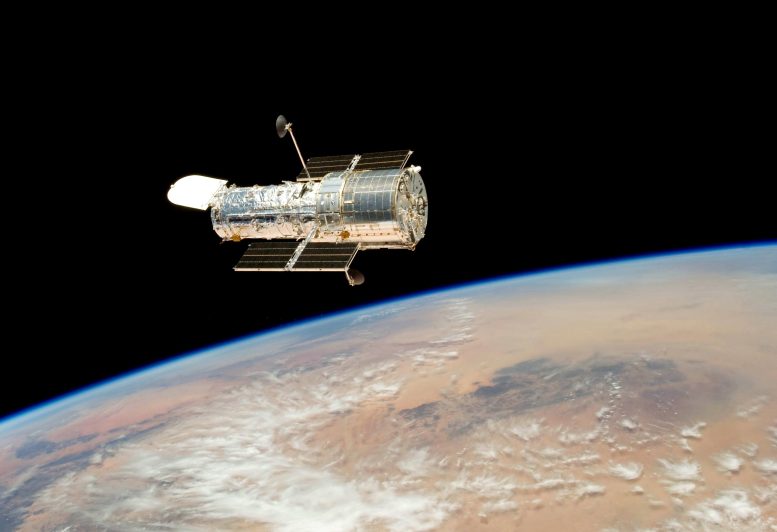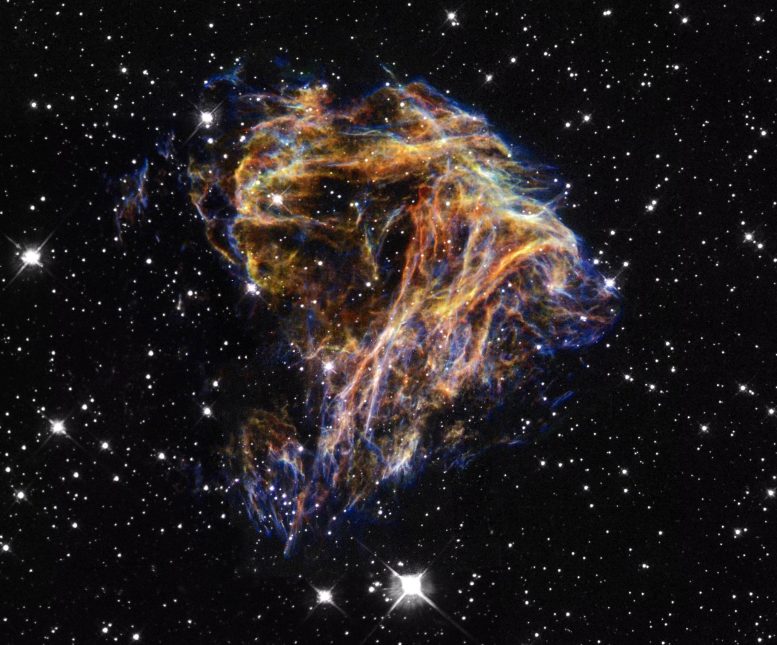Hubble’s Stunning View of a Stellar Explosion in the Large Magellanic Cloud
Resembling sparks from a fireworks display, this image taken by a JPL camera onboard NASA’s Hubble Space Telescope shows delicate filaments that are sheets of debris from a stellar explosion in the nearby Large Magellanic Cloud galaxy. Credit: NASA/JPL/Hubble Heritage Team (STScI/AURA)
The Hubble Space Telescope captured this spectacular image of a stellar explosion throwing out sheets of debris in the nearby Large Magellanic Cloud galaxy on July 7, 2003. Since its 1990 launch, Hubble has changed our fundamental understanding of the universe; with over 1.5 million observations and 20,000+ papers published on its discoveries, Hubble is the most productive science mission in the history of NASA.
Large Magellanic Cloud
The Large Magellanic Cloud (LMC) is a satellite galaxy of the Milky Way. Located about 163,000 light-years away, it’s one of the closest galaxies to our own. The LMC is a dwarf galaxy, notable for its irregular shape, and it’s visible from the southern hemisphere. It’s an important site for astronomical research, particularly in understanding galactic formation and evolution, as it hosts a variety of stellar types and interstellar clouds.

Hubble drifts over Earth after its release on May 19, 2009, by the crew of the Space Shuttle Atlantis. The crew had performed all planned tasks over the course of five spacewalks, making the Servicing Mission 4 (SM4), the fifth astronaut visit to the Hubble Space Telescope, an unqualified success. Credit: NASA
Hubble Space Telescope
The Hubble Space Telescope is a significant observatory in space, launched by NASA in 1990. Orbiting Earth, it’s been providing unparalleled views of the universe, free from the distortion of Earth’s atmosphere. Hubble has contributed to major breakthroughs in astronomy, including the determination of the rate of expansion of the universe. It’s equipped with a range of instruments allowing it to observe in various spectrums of light, from ultraviolet to near-infrared, making it a versatile tool for exploring the cosmos.

Resembling sparks from a fireworks display, this image taken by a JPL camera onboard NASA’s Hubble Space Telescope shows delicate filaments that are sheets of debris from a stellar explosion in the nearby Large Magellanic Cloud galaxy. Credit: NASA/JPL/Hubble Heritage Team (STScI/AURA)
The Hubble Space Telescope captured this spectacular image of a stellar explosion throwing out sheets of debris in the nearby Large Magellanic Cloud galaxy on July 7, 2003. Since its 1990 launch, Hubble has changed our fundamental understanding of the universe; with over 1.5 million observations and 20,000+ papers published on its discoveries, Hubble is the most productive science mission in the history of NASA.
Large Magellanic Cloud
The Large Magellanic Cloud (LMC) is a satellite galaxy of the Milky Way. Located about 163,000 light-years away, it’s one of the closest galaxies to our own. The LMC is a dwarf galaxy, notable for its irregular shape, and it’s visible from the southern hemisphere. It’s an important site for astronomical research, particularly in understanding galactic formation and evolution, as it hosts a variety of stellar types and interstellar clouds.

Hubble drifts over Earth after its release on May 19, 2009, by the crew of the Space Shuttle Atlantis. The crew had performed all planned tasks over the course of five spacewalks, making the Servicing Mission 4 (SM4), the fifth astronaut visit to the Hubble Space Telescope, an unqualified success. Credit: NASA
Hubble Space Telescope
The Hubble Space Telescope is a significant observatory in space, launched by NASA in 1990. Orbiting Earth, it’s been providing unparalleled views of the universe, free from the distortion of Earth’s atmosphere. Hubble has contributed to major breakthroughs in astronomy, including the determination of the rate of expansion of the universe. It’s equipped with a range of instruments allowing it to observe in various spectrums of light, from ultraviolet to near-infrared, making it a versatile tool for exploring the cosmos.
